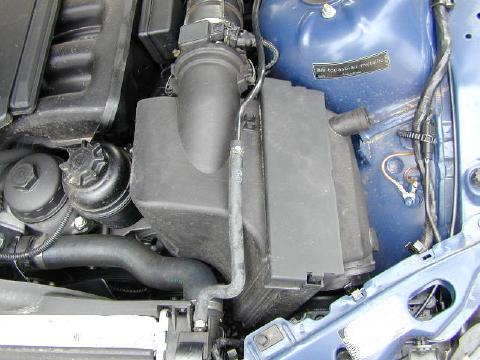
We wanted to see what could be done to increase airflow without doing anything permanent to his car.
First thing to do was take a look at the airbox itself.

And you can see it is a fairly tight fit in the engine bay.
The filter is positioned totally differently then in the 1.9l. These filters slide into the top of the airbox like a slice of toast.
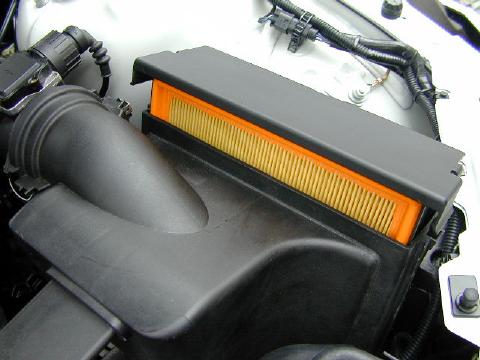
After pulling the filter we noticed the first problem. The filter on Dave's car has a foam on the bottom of it as a noise deadener. BMW has started using these filters on E46s but I hadn't heard of them being in the Zs before and according to the parts CD it shouldn't be there.
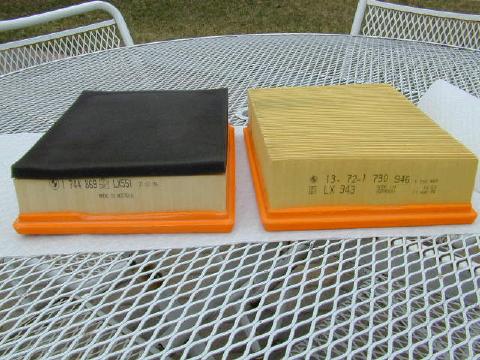
Luckily, we had a proper filter which is shown on the right for a comparison.
Next we pulled the airbox to see what could be done. To remove the airbox
there is one 10mm nut on the drivers side. Then you need to unclip the
coolant overflow line from the top of the box so it has some play. The
wire
running to the HFM needs to be removed, you simply squeeze down on
silver spring clip and the connector will come right off. Finally loosen
the hose clamp holding the intake bellows to the HFM and pull the bellows
free.
The airbox should lift right out. Installation is the reverse of the
above and make sure you get the plastic cup on the bottom of the airbox
seated over the rubber ball.
With the box out you can easily see the factory scoop which grabs air from all around the headlights and between them and the radiator. This is an improved design from what BMW has used on earlier 2.8ls though it does have some air leaks.

On the side of the airbox there is a screw which holds the intake funnel into the box.

If you unscrew that the funnel will just pull right out the front of the airbox. The funnel on this box is of a pretty good size but we wanted to pull it out to see what the effect would be. Pulling out the funnel results in a slight gap between the opening to the airbox and the factory scoop as shown below.
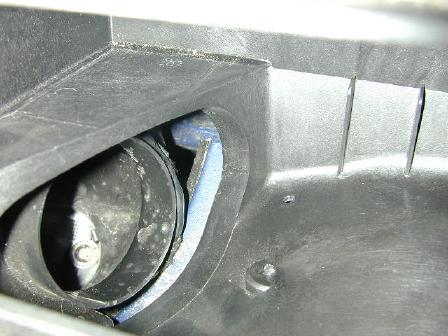
The good news though is the airbox itself actually forms a shield against the radiator to keep hot engine air away from the intake into the box.
So now we knew what we were going to do so we made two second gear runs with the car stock (and the foam filter in place) then replaced the filter and pulled out the inlet to the airbox and repeated the runs.
The result?
Not too much actually.

We didn't end up with the greatest spread of data points (six cylinders
are through second gear pretty quickly) but it appears that there was a
slight increase in the upper mid-range then again a slight increase near
red-line. I don't know where the VANOS and DISA transition points are on
this engine so that may have something to do with the two different areas
the mod appeared to help slightly on.
Now the big question was how was the engines breathing?
If you look at the curve above you see the slope of the 'post' line
is fairly straight. This means the engines
breathing isn't falling off at higher RPM like it did on the 1.9l.
I haven't worked out all the volumtric effeciency numbers yet but it looked
like the VE was still pretty high at redline. What this tells you is that
the airbox is flowing well enough to keep from choking the engine at high
RPM. IOW, modding the airbox (or changing to a cone) isn't going to do
much (if anything) to your engines airflow. Each cylinder on the 2.3 is
basically smaller then a corresponding cylinder on a 1.9l (smaller bore
and stroke) so to fill it better (higher VE) less air needs to be taken
in the time the cylinder is opened. The engine has two extra cylinder which
accounts for the increased displacement and air taken into the engine.
Off topic: Because of the shorter stroke in the 2.3 the piston speed at redline (and the associated inertial stresses) are lower on the 2.3 as compared to the other engines. The 2.3l engines pistons are moving at about an average of 3195 feet per minute (FPM) at 6500rpm, 1.9l is at 3564 fpm, 2.8l is 3585 fpm and the 3.2l is at 3824 fpm. 3500 fpm is considered the limit for long engine life in most books. The pistons in the M are travelling almost 20% faster then in a 2.3l at 6500rpm.
We also checked intake air temperature to make sure the gap wasn't increasing temperature of the intake air. It wasn't. However we did find that the intake air (both stock and modded) was about 20 degrees above ambiant. As a reference a Fogged 1.9ls intake temp. is about 2 degrees above ambiant. The temp. sensor on the 2.3 may be located in the intake manifold which would have a lot to do with that temp. increase. Still it might not be a bad idea to add a little heat shielding around the airbox to shield it from the radiator hose which is pushed right up against it.
So is it worth pulling that inlet and making sure you have the proper airfilter in the 2.3l?
Probably. Taking out the inlet is a five minute affair which can be reversed later on if desired. Until you pick up the proper filter there is a quick solution....
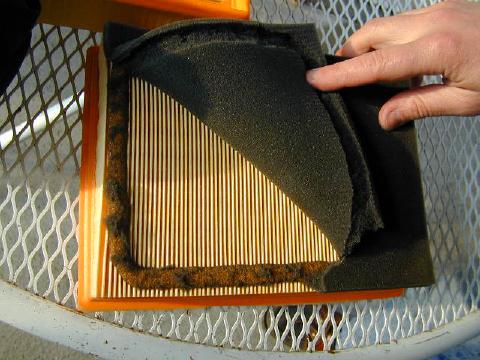
but because the paper pleats on this filter are smaller then on the correct filter (part# 13 72 1 730 946) you should install the proper filter for longer filter life and possibly slightly better flow. I checked at PepBoys and they have the non-foam Purolator airfilter listed and in stock for about $13. If you are really ambitious you could increase the size of the hole in the factory scoop and connect the two again with a large airhose but it really may not be worth the effort.
So the end result was a very slight improvement for little work but more importantly we learned a lot about the flow potential of the engine.